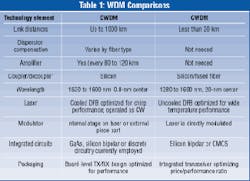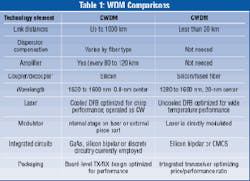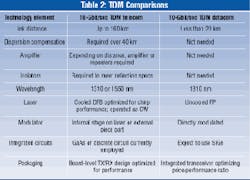Components and cost considerations for 10 Gbits/sec in the enterprise backbone
Components and cost considerations for 10 Gbits/sec in the enterprise backbone
As Gigabit Ethernet reaches general deployment, new demands will be placed on enterprise backbones.
THOMAS DUDLEY, Lucent Technologies Microelectronics Group
IEEE 802.3 Ethernet standards spawned a successive upward bandwidth migration from 10 to 100 Mbits/sec to today`s 1 Gbit/sec. As a backbone technology, Gigabit Ethernet is gaining widespread acceptance as a replacement for the lower-speed Ethernet standards. But as bandwidth demands move Gigabit Ethernet to the desktop, even higher backbone data rates will be necessary to alleviate congestion. The next logical step, therefore, is 10 Gbit/sec in the backbone. At the component level, it is important to examine two possible and likely methods of implementing 10-Gbit/sec transmission--time-division multiplexing (TDM) and coarse wavelength-division multiplexing (WDM).
Historical perspective
Optical components operate transparently to the system protocol or standard, but it is worth looking at Ethernet for a reference point in estimating component availability requirements. More than 30 months passed from the formation of an initial study group to final approval of both the Fast Ethernet and Gigabit Ethernet standards. Assuming that a similar timeline is true for 10-Gbit Ethernet, and that a study group was formed by February 1999, final approval of a 10-Gbit/sec Ethernet standard by third quarter 2001 is realistic. Assuming further, rapid market adoption, 10-Gbit/sec Ethernet may become the primary backbone link by first quarter 2002.
The date is important for two reasons--for the user to calculate bill-of-material costs and manufacturing ramp plans and to schedule component availability requirements. Again looking at historical trends, it is likely that initial components are needed 18 months before widespread acceptance for initial prototyping and demonstration systems. In effect, the question becomes, "What components will be available by third quarter 2000?"
As rates migrate to 10 Gbits/sec, additional changes in the level of transceiver functionality are expected. Challenges exist, especially in the realm of accessing turnkey solutions that are likely to be available by a limited number of vendors with high-speed expertise.
10-Gbit/sec TDM
An attractive method of 10-Gbit/sec transmission in the building backbone, campus backbone, or metropolitan area network (MAN) environment is a TDM solution. Within the TDM approach for 10-Gbit/sec applications, Fabry-Perot (FP) laser-based transceivers have a distinct advantage over multimode technology in terms of cost of components, total cost of ownership, performance, and "futureproofing" of the network.
A traditional level of functionality in data-communications transceivers is provided by a laser and a laser-driver integrated circuit (IC) on the transmit side and by a detector and transimpedance and post-amplifier ICs on the receiver side. Using the IEEE 802.3 layer model as a reference, this combination of electronics and optical components is referred to as the physical medium-dependent (PMD) sublayer of a complete physical layer. Data-communications transceivers with PMD functionality at lower speeds are commodity products, provided by several vendors in either 1- or 0.5-inch-wide packages with multisourced footprints (see Fig. 1).
As speeds migrate to higher data rates, there is a trend to incorporate higher levels of functionality. Evidence of this trend is visible today, as standard products are now available with a clock-recovery function in the standard footprint.
At 10 Gbits/sec, the optical transceiver will most likely contain multiplexers to construct a bit stream, clock timing and recovery, and deserialization function, in addition to the functions of the PMD sublayer. This added functionality is referred to as the physical medium attachment (PMA) sublayer. The PMA and PMD sublayers interface with other sublayers to form a complete physical layer. A 10-Gbit/sec Ethernet bit stream will likely be demultiplexed to 10 1-Gbit/sec signals. (The actual data rate for 10-Gbit/sec transmission is 12.5 Gbits/sec, assuming the same encoding scheme is used as Ethernet is scaled). ATM at 10 Gbits/sec will likely be demultiplexed to 622 Mbits/sec.
Elements of a 10-Gbit/sec transceiver that need to be considered to assess future component availability include the source, detector, and electronics (see Fig. 2). The recommended source for 10-Gbit/sec transmission is an uncooled 1.3-micron FP laser, as chip design, packaging, and processing for FP lasers are already well understood. With such a device, good performance is demonstrated at 12.5 Gbits/sec on 3 km of singlemode fiber, as well as feasibility over 300 m of 50-micron fiber. The FP laser combines effectively with an InP pin detector, already field-proven at 10 Gbits/sec. Both source and detector assemblies are expected to benefit from additional packaging cost improvements, including a migration to nonhermetic packages over the short term.
Proponents of an 850-nm vertical-cavity surface-emitting laser (VCSEL) technology for 10 Gbits/sec exist. Bandwidth-distance limitations, however, restrict its appeal as an upgrade technology. With current technology, transmission distance at 10 Gbits/sec at this wavelength is difficult to predict and, at best, transmission distance will be very limited. It is argued that a new class of multimode fiber can be developed and optimized for short-wavelength transmission, but considering the variations of application type and legacy installation, component standardization is not supported.
In addition to 850-nm VCSEL technology, 1300-nm VCSELs have also been proposed. But this technology would require a significant manufacturing breakthrough to achieve commercial parity with FP lasers. In any event, VCSEL technology would not support transmission in the campus/MAN environment, further eroding possibilities of standardization for components.
In contrast, FP lasers are optimized for singlemode fiber, the predominant fiber type installed in the campus/MAN. Still FP lasers face some distance limitations in the building backbone, where 96% of the currently installed base is 62.5-micron fiber. The fact is that neither a VCSEL nor an FP source would be adequate for all building backbone applications at 10 Gbits/sec on the existing fiber base. But in upgrading the building infrastructure, the only real futureproofing is available with singlemode fiber. Singlemode also provides complete compatibility with the campus back bone/MAN. In addition, singlemode fiber today enjoys an estimated cost advantage of 10 cents per meter over multimode fiber; specialty multimode fiber could further widen the singlemode cost advantage.
While low-cost optical components are available now, commercial availability of low-cost electronics specific to 10-Gbit/sec use is extremely limited. The landscape for IC availability is expected to improve drastically over the next two years as silicon-germanium (SiGe) material becomes available. SiGe combines the integration and cost benefits of silicon with the speed of more expensive technologies such as gallium arsenide. Germanium introduced into all-silicon bipolar transistors provides significant improvements in operating frequency, current, noise, and power, without a penalty for its use.
The first SiGe solution for transceiver circuits will likely be available in approximately one year. The cost and availability of these ICs would be on par, regardless of the source and detector type used in the transceiver. The state of the art in VCSEL versus FP laser technology in terms of the parameters that affect the laser-driver design (i.e., threshold and modulation currents) is not significant enough to affect the cost of these ICs; and improvements in the laser technology are expected to coincide. Receiver circuitries, as well as the ICs used in high-level sublayers, are identical.
Relative to component costs for Gigabit Ethernet, VCSEL-based transceivers have an estimated 20% cost advantage over FP-based transceivers at equal volumes. As IC costs rise as the circuits move to 12.5 Gbits/sec, the differential narrows. And, as redefined transceivers include both PMD and PMA functions, the cost differential is further reduced as ICs contribute more to the overall cost of the transceiver.
When considering the cost of components, total cost of ownership, performance, and futureproofing of the network, FP transceivers have an advantage over multimode technology. 10-Gbit/sec TDM solutions using FP-based transceivers operating over either singlemode or multimode fiber will also offer high-performance, cost-effective solutions for intra-enclosure applications.
10-Gbit/sec CWDM solution
WDM is a popular technology for transmitting multiple data streams on individual wavelengths (or channels) over a single fiber. In telecommunications applications with distances of up to 1000 km, dense WDM (DWDM) is the preferred technology. In enterprise applications, however, DWDM is overkill in both price and capacity. DWDM is up to 25 times more expensive than is required for wide-scale deployment in enterprise applications.
Whereas DWDM is based on a 0.8-nm center, an alternative WDM technique redefined as coarse WDM (CWDM) can use a substantially wider spacing--possibly 20 nm on center. This alternative uses a greater portion of the spectrum. If 10-Gbit/sec transmission is based on four channels of 2.5 Gbits/sec each, the proposed channels are 1510, 1530, 1550, and 1570 nm. However, if CWDM were based on 10 channels of 1 Gbit/sec (actually 1.2-Gbit/sec data rate for Gigabit Ethernet), then 200 nm of the wavelength spectrum would be used.
The typical wavelength window of DWDM is 1530 to 1565 nm--recently increased to 1600 nm to accommodate demand for higher channel counts. This window is still relatively narrow to capitalize on the region around 1550 nm, where the attenuation in silica fiber reaches a minimum while matching the capabilities of fiber amplifiers that have the greatest gain in this region. Although this capacity is critical in long-haul transport systems, achieving the desired link budget at a minimum cost is the major consideration for enterprise backbones.
Enterprise systems, by definition, are of substantially shorter distance. A qualitative estimate is that 6% of the total enterprise network backbone market is campus/MAN and more than 90% of these specific lines are less than 10 km. At these distances, attenuation in the fiber is less important. Except for a small portion around the 1400-nm wavelength band, the attenuation is no worse than 0.4 dB per kilometer, so for a 10-km link there will only be 4 dB of loss allocated to fiber attenuation. With 20-nm spacing, 14 usable channels exist between 1280 and 1600 nm, and the extra channels around 1400 nm could be usable if the added loss can be tolerated. In the meantime, singlemode fiber that eliminates the water absorption region is being introduced, further improving attenuation across the entire range of 1280 to 1600 nm.
At enterprise distances, there is also no need to use fiber amplifiers, eliminating concern of being confined to gain regions of amplifiers and removing a major cost element from the system.
The approach may be a more desirable solution for the campus backbone/MAN, but the following considerations may make it an unattractive solution for building backbones:
Network management problems may become more complicated.
Training and staffing issues are more critical since the network administrator will be supporting additional technologies/protocols.
CWDM is not as integrated a solution in the building backbone where space in the switch and wiring cabinets is an issue.
CWDM is still more expensive than the 10-Gbit/sec TDM approach.
Advantages exist, however. In a larger enterprise, the MAN is defined as the network interconnecting company operations within a certain geographic area. Alternatively, the MAN could be the network managed by local-exchange carriers to interconnect multiple enterprises to a central office switch. In either case, the scope is significant enough that multiple local area networks (LANs) with different operating protocols or standards may be in operation. Instead of consuming bandwidth by adding overhead by packaging one protocol into the payload of another carrier protocol, separate wavelength channels would be assigned for data transport. Also, DWDM offers greater potential for scalability to even higher total data rates.
Figure 3 illustrates the components that may be used in a CWDM solution. There may be numerous ways to deal with the passive components in a CWDM implementation. The functionality described as TX wln and RX with filter for wln would be configured as an integrated transceiver. At sonet/sdh wavelengths, this functionality is commercially available now. A laser used in the transmit side of the transceiver in this CWDM environment needs to be tuned to a specific wavelength. Given the wavelength temperature-related variability of the laser, a distributed feedback (DFB) laser would be used. The proposed 20-nm on-center spacing is based upon the known wavelength drift of DFB lasers. With a wavelength-temperature coefficient of 0.09 nm per C, the wavelength can vary up to 11C, worst case. Since low cost is the primary driver, the 20-nm on-center spacing also includes a conservative manufacturing margin and a consideration of the variability in far-end and near-end lasers. To optimize inventory management in this particular implementation, a wide passband filter should also be packaged on the receiver side of the transceiver to match the transmit-side wavelength. A family of low-cost transceivers, sold by wavelength, could result. The technology for wavelength-specific transceivers is available now, waiting for market demand to materialize in order to drive product commercialization.
The other key component in the CWDM approach shown in Figure 3 is a passive coupler/decoupler or router. This figure shows a point-to-point configuration; however, there may be multiple passive couplers in a CWDM system as channels are added from various LAN switches. Likewise, multiple decouplers may be used as traffic is offloaded to specific LAN sites. In this configuration, if a decoupler is used, all traffic (regardless of wavelength) is split from the MAN data stream and directed to the transceiver on the LAN switch. The optical interface on the switch would have the passband filter to screen only traffic for the designated address.
Finally, the LAN edge switch would be responsible for converting the incoming signal from the wavelength used for MAN transmission to the wavelength resident on the LAN (or possibly other source/media conversion).
Currently, coupler/decoupler technology is based on waveguides grown on silicon--and are relatively expensive components. Additionally, the couplers / decouplers will introduce a significant loss into the link-budget calculations. Silicon routers combined with the passband filters may still be the technology to consider as CWDM systems are implemented. But there may be other promising options and architecture configurations that include fused fibers and/or micro-optic circulators.
Tables 1 and 2 highlight system differences and component comparisons in enterprise versus telecommunications transmission networks. Although similar in theory, there are drastic differences affecting price. Understanding the options and differences should allow equipment vendors and network administrators to better arrive at accurate cost projections for future product introductions.
Today, 10-Gbit/sec TDM represents the lowest-cost technology in terms of components and can provide a solution for both building backbones and campus/MANs. Transceivers based on FP lasers offer superior flexibility for multiple applications while providing futureproofing for the network. Although 10-Gbit/sec CWDM technology may have a higher initial cost, it offers better scalability and flexibility within the MAN/campus backbone. q
Thomas Dudley is manager, access and datacom products, at Lucent Technologies` Microelectronics Group (Brei nigsville, PA).Fig. 3. Couplers, decouplers, and transceivers that compose coarse WDM.





